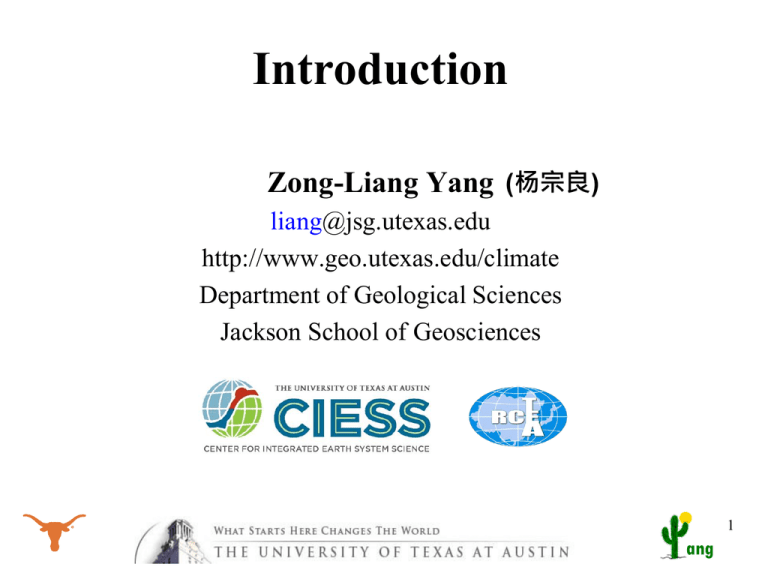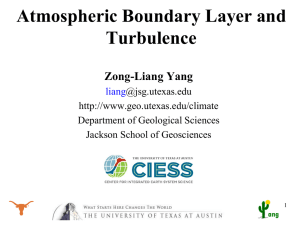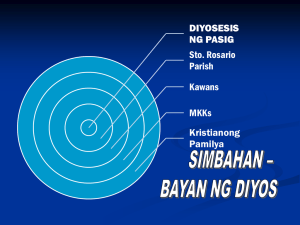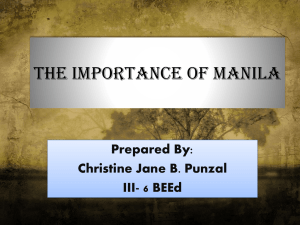Introduction - The Department of Geological Sciences
advertisement

Introduction Zong-Liang Yang (杨宗良) liang@jsg.utexas.edu http://www.geo.utexas.edu/climate Department of Geological Sciences Jackson School of Geosciences 1 ang Who Am I? Name: Zong-Liang YANG Professor, Jackson Chair in Earth System Science Director, Center for Integrated Earth System Science Education: BSc and MSc in Meteorology PhD in Atmospheric Science Research: Land Surface Modeling, Model Development & Evaluation Land–Atmosphere Interaction, Climate Modeling, Climate Change and Impacts on Water Resources and Environment Teaching: Living with a Planet; Earth, Wind and Fire Physical Climatology; Climate: Past, Present and Future Hydroclimatology; Land–Atmosphere Interaction Dynamics Email: liang@jsg.utexas.edu ang My Education and Work Places China He’nan Province: 16 years Nanjing: 5 years Shanghai: 1 year Australia Melbourne: 3 years Sydney: 4 years USA Tucson: 8 years Austin: 13 years ang Two Major References ang Course Website at Univ of Texas at Austin • Course website www.geo.utexas.edu/courses/387H/SyllabusLAID.htm • Provides lists of lecture topics, reading assignments and homework. • Includes syllabus and grading policy. ang Outline • Introduction • Land as a Key Component in the Earth System • Land–Atmosphere Interaction – Water Balance – Energy Balance – Carbon Balance • Sensitivity and Feedbacks • Summary 6 ang Why Land • Land research has direct societal relevance: we all live on land. • Land provides us food, clothing, shelter, and infrastructure. • Land is at the central stage for extreme weather and climate events (droughts, floods, dust storms, bush fires). • Land processes are complex, highly heterogeneous, multidisciplinary, and multi-scale! 7 ang DYNAMIC GLOBAL LAND TRANSITIONS LANDUSE LANDCOVER [Human control] [Biophysically controlled] Human Systems -Institutions -Culture -Technology -Population -Economic Economic Problems -poverty -unequal wealth -war -globalization Running 2006 HUMAN DECISION MAKING political/economic choices Ecological Problems -pollution -diseases -food/fibre/fuel shortages -overcrowding Ecological Systems -Biogeochemistry -Genetic bank -Water -Air Ecosystem goods & services -clean air/water -waste recycling -food/fibre/fuel -recreation 8 ang Climate Change: Greenhouse Gases versus Land Use and Land Cover Change IPCC 2007 9 Foley et al. 2005 ang What Are Land Surface Processes • Land surface consists of – urban areas, soil, vegetation, snow, topography, inland water (lake, river) … • Land surface processes describe – exchanges of momentum, energy, water vapor, CO2, dusts, and other trace gases/materials between land surface and the overlying atmosphere – states of land surface (e.g., soil moisture, soil temperature, canopy temperature, snow water equivalent) – characteristics of land surface (e.g., soil texture, surface roughness, albedo, emissivity, vegetation type, cover extent, leaf area index, and seasonality) 10 ang The Hydrologic Cycle 11 ang The Hydrologic Cycle On land: PL – EL = Q (assumptions) Globally: P – E = 0 12 ang Earth’s Global Energy Budget 80% of net radiation at the surface is used for evaporation! Trenberth et al. (2009) ang Terrestrial Carbon Cycle • Growth, mortality, decay • GPP: Gross Primary Production (climate, CO2, soil H2O, resource limitation) • Ra: Autotrophic respiration (T, live mass,…) • Rh: Heterotrophic respiration: Decay (T, soil H2O,..) • NPP=GPP – Ra • NEP=Rh – NPP GPP 120 PgC/yr Ra 60 Rh 60 800 PgC 1200 PgC ang NCAR Community Land Model (CLM4) for Climate Models in 2010 15 Co-Chairs: David Lawrence (NCAR), Zong-Liang Yang (Univ of Texas at Austin), 2008-2013 ang 2010 NOAA/NCEP Land Modeling Workshop at Austin, Texas 1 ang6 2014 GEWEX Science Conference, The Netherlands 17 ang Do Land Surface Processes Matter to Climate Prediction? Observed transient soil moisture anomalies can be more important to accurately predict mid-continental summertime extreme rainfalls (in USA) than sea surface temperatures (Entekhabi et al., 1999). 18 ang Soil Moisture–Precipitation Feedback Loops 19 Pitman (2003) ang Land–Atmosphere Coupling Strength The greatest land– atmosphere coupling appears to lie in arid-to-humid transition zones, where soil moisture anomalies strongly influence precipitation anomalies (Koster et al., Science, 2004). Kim and Wang (2007) found that soil moisture-induced precipitation increase is enhanced under wet summer when vegetation phenology is included in their model, consistent with the findings of others (e.g., Dickinson and Henderson-Sellers, 1988; Hoffmann et al,. 2000; Matsui et al., 2005; Xue et al. 2006). The profile of soil moisture can be determined by the water table position (e.g., Levine and Salvucci, 1999). Shallow groundwater table sustains surface vegetation, especially during drought (e.g., York et al., 2002). 20 ang Many, many studies have provided evidence for mechanisms resulting in atmospheric sensitivity to land surface exchanges Shuttleworth (2011) Moisture recycling Influence of topography Potential Evaporation Foehn Effect Differential Heating Precipitation Contours (mm/day) Changes in soil moisture Regional Changes in frozen precipitation Mesoscale No Evaporation (Shukla and Mintz, 1982) Seasonal vegetation Wind Observations Interactive vegetation + groundwater Divergence Convergence (Koster et al, 2006) Gutzler & Preston (1997) (Taylor et al, 2006) Imposed change of land cover Local climate Regional Jiang et al., 2009 Heterogeneity ang Urban Heat Island Werth & Avissar (2002) Weaver & Avissar (2002) There is now a MASSIVE literature that provides evidence for atmospheric sensitivity to land surface exchanges see, for example, the references in the review of “Atmospheric Sensitivity to Land Surface Exchanges” in Chapter 25 of Terrestrial Hydrometeorology (Shuttleworth; 2011) Avissar, R., and Liu, Y.Q. (1996) J. Geophys. Res. 101(D3), 7499-7518. Barnett, T.P., Adams, J.C., and Lettenmaier, D.P. (2005) Nature 438(17), 303-309. Bastable, H.G., Shuttleworth, W.J., Dallarosa, R.L.G., Fisch, G. and Nobre, C.A. (1993) Int. J. Clim. 13, 783–796. Baumgartner, A. and Reichel, E. (1975) The World Water Balance. Elsevier, Amsterdam. 179 pp. Beljaars, A.C.M., Viterbo, P., Miller, M.J., and Betts, A.K. (1996) Mon. Weather Rev. 124(3), 362-383. Betts, A.K., Ball, J.H., Beljaars, A.C.M., Miller, M.J. and Viterbo, P. (1996) J. Geophys. Res. 101(D3), 72097225. Betts A.K., Viterbo, P., Beljaars, A.C.M., Pan, H-L., Hong, S-Y., Goulden, M.L. and Wofsy, S.C. (1998) J. Geophys. Res. 103(D18), 23079-23085. Bosilovich, M.G., Schubert, S.D, and Walker, G. (2005) J. Clim. 18, 1591-1608. Bowling, L.C., Lettenmaier, D.P., Nijssen, B., Graham, P.L., Clark, D., Maayar, M.E., Essery, R., Goers, S., Habets, F., van der Hurk, B., Jin, J., Kahan, D., Lohmann, D., Mahanama, S., Mocko, D., Nasonova, O., Niu, G.-Y., Samuelsson, P., Shmakin, A.B., Takata, K., Verseghy, D., Viterbo, P., Ma, X., Xue, Y. and Yang, Z.-L. (2003) Global and Planet. Change 38, 1-30. Brown, D.P. and Comrie, A.C. (2002) Climate Res. 22, 115–128. Brubaker, K.L., Entekhabi, D. and Eagleson, P.S. (1993). .J Clim. 6, 1077–1089. Costa, M.H. and Foley, J.S. (1999) J. Geophys. Res. 104(D12), 14189-14198. Cox, P.M., Huntingford, C. and Harding, R.J. (1998) J. Hydrol. 213(1-4), 79-94. Daly, C., Neilson, R.P. and Phillips, D.L. (1994) J. Appl. Meteorol. 33, 140-158. Daly, C., Halbleib, M., Smith, J.I., Gibson, W.P., Doggett, M.K., Taylor, G.H., Curtis, J., and Pasteris, P.A. (2008) nnt. J. Clim. 28, 2031-2064. Dickinson, R.E., Henderson-Sellers, A., Kennedy, P.J. and Wilson, M.F. (1986) NCAR Tech. Note, TN-275+STR, 72 pp. Dickinson, R.E., Shaikh, M., Bryant, R. and Graumlich, L. (1998) J. Clim. 28, 2823-2836. Dominguez, F. and Kumar, P. (2008) J. Clim. 21, 5165–5186. Dominguez, F., Kumar, P. and Vivoni, E.R. (2008) J. Clim. 21, 5187–5203. Eltahir, E.A.B. and Bras, L. (1996) Precipitation recycling. Rev. Geophys. 34(3), 367-378. Entekhabi, D., Njoku, E., O’Neill, P., Kellogg, K., Crow, W., Edelstein, W., Entin, J., Goodman, S., Jackson, T., Johnson, J., Kimball, J., Piepmeier, J., Koster, R., McDonald, K., Moghaddam, M., Moran, S., Reichle, R., Shi, J.C., Spencer, M., Thurman, S., Tsang, L. and Van Zyl, J. (2010). Proc. IEEE 98(5). Etchevers, P., Martin, E., Brown, R., Fierz, C., Lejeune, Y., Bazile, E., Boone, A., Dai, Y., Essery, R., Fernandez, A., Gusev, Y., Jordan, R., Koren, V., Kowalcyzk, E., Nasonova, N.O., Pyles, R.D., Schlosser, A., Shmakin, A.B., Smirnova, T.G., Strasser, U., Verseghy, D., Yamazaki, T. and Yang, Z.-L. (2004) Ann. Glaciol. 38, 150-158. Fassnacht, S.R., Yang, Z.-L., Snelgrove, K.R., Soulis, E.D. and Kouwen, N. (2006) J. Hydrometeorol. 7, 298-304. Findell, K.L. and Eltahir, E.A. (1997) Water Resour. Res. 33, 725–735. Gochis, D.J., Jimenez, A., Watts, C.J., Garatuza-Payan, J. and Shuttleworth, W.J. (2004) Mon. Weather Rev. 132, 2938–2953. Gopalakrishnan, S.G., Roy, S.B. and Avissar, R. (2000) J. Atmos. Sci. 57, 334–351. Gutzler, D. and Preston, J. (1997) Geophys. Res. Lett. 24, 2207–2210. Higgins, W. and Gochis, D. (2007) 20, 1601-1607. IPCC (2007) available at http://www.ipcc.ch. Jiang, X., Niu, G.-Y. and Yang, Z.-L. (2009) J. Geophys. Res. 114, D06109, doi:10.1029/2008JD010756. Johnson, G., Daly C., Hanson, C.L., Lu, Y.Y. and Taylor, G.H. (2000) J. Appl. Meteorol. 39, 778-796. Kerr, Y., Waldteufel, P., Wigneron, J.-P., Martinuzzi, J.-M., Font, J. and Berger, M. (2001) IEEE Trans. Geosci. Remote Sens. 39, 1729–1736. Korzun, V.I. (1978) Studies and Reports in Hydrology 25. UNESCO, Paris. Koster, R.D., Guo, Z., Dirmeyer, P.A., Bonan, G., Chan, E., Cox, P.M., Davies, H., Gordon, C.T., Kanae, S., Kowalczyk, E., Lawrence, D., Liu, P., Lu, C.-H., Malyshev, S., McAvaney, B., Mitchell, K., Mocko, D., Oki, T., Oleson, K .W., Pitman, A., Sud, Y.C., Taylor, C.M., Verseghy, D., Vasic, R., Xue, Y. and Yamada, T. (2006) J. Hydrometeorol. 7(4), 590–610. Liu, Y., Weaver, C.P. and Avissar, R. (1999) J. Geophys. Res. 104(D16), 19515-19533. doi:10.1029/1999JD900361. Luo, L., Robock, A., Vinnikov, K.Y., Schlosser, C.A., Slater, A.G., Boone, A., Braden, H., Cox, P., de Rosnay, P., Dickinson, R.E., Dai, Y., Duan, Q., Etchevers, P., Henderson-Sellers, A., Gedney, N., Gusev, Y.M., Habets, F., Kim, J., Kowalczyk, E., Mitchell, K., Nasonova, O.N., Noilhan, J., Pitman, A.J., Schaake, J., Shmakin, A.B., Smirnova, T.G., Wetzel, P., Xue, Y., Yang, Z.-L. and Zeng, Q.-C. (2003) J. Hydrometeorol. 4, 334-351. Makarieva, A.M. and Gorshkov, V.G. (2007) Hydrol. Earth Syst. Sci. 11, 1013–1033 Matsui, T., Lakshmi, V. and Small, E.E. (2005) The Millennium Ecosystem Assessment report. Available at: http://www.millenniumassessment.org/en/Index.aspx. Narisma, G.T. and Pitman, A.J. (2003). Hydrometeorol. 4(2), 424–436. Nijssen, B., Bowling, L.C., Lettenmaier, D.P., Clark, D., http://www.millenniumassessment.org/en/Index.aspx. Maayar, M.E., Essery, R., Goers, S., Habets, F., van der Hurk, B., Jin, J., Kahan, D., Lohmann, D., Mahanama, S., Mocko, D., Nasonova, O., Niu, G.-Y., Samuelsson, P., Shmakin, A.B., Takata, K., Verseghy, D., Viterbo, P., Ma, X., Xia, Y., Xue, Y. and Yang, Z.-L. (2003) Global Planet. Change 38, 31-53. Niu, G.-Y. and Yang, Z.-L. (2004) J. Geophys. Res. 109, D23111, doi:10.1029/2004JD004884. Niu, G.-Y. and Yang, Z.L. (2006) J. Hydrometeorol. 7(5), 937-952. Niu, G.-Y. and Yang, Z.-L. (2007). Geophys. Res. 112, D21101, doi:10.1029/2007JD008674. Oki, T. and Kanae, S. (2006) Science 313(5790), 1068 1072. Salati, E., Dall'Olio, A., Matsui, E. and Gat, J.R. (1979) Water Resour. Res. 15(5), 1250–1258. Sellers, P.J., Mintz, Y., Sud, Y.C. and Dalcher, A. (1986) J. Atmos. Sci. 43, 505-531. Sellers, P.J., Randall, D.A., Collatz, C.J., Berry, J.A., Field, C.B., Dazlich, D.A., Zhang, C., Collelo, G. and Bounoua, L. (1996) J. Clim. 9, 676-705. Shukla, J. and Mintz, Y. (1982) Science 215(4539), 1498-1501. Shuttleworth, W.J. (2006) Trans. ASABE 49(4), 925-935. Shuttleworth, W.J. and Wallace, J.S. (2010) Trans. ASABE 52(6),1895-1906. Shuttleworth, W.J., Zreda, M., Zeng, X., Zweck, C., and Ferre, P.A. (2010) Proceedings of the British Hydrological Society's Third International Symposium: Newcastle University, 19-23 July 2010. ISBN: 1 903741 17 3. Taylor, C.M., Parker, D.J. and Harris, P.P. (2007) Geophys. Res. Lett. 34, L15801, doi:10.1029/2007GL030572. Teuling, A.J., Seneviratne, S.I., Williams, C. and Troch, P.A. (2006) Geophys. Res. Lett. 33. L23403. doi:10.1029/2006GL028178. Tucker, D.F. and Crook, N.A. (1999) Mon. Weather Rev. 127, 1259-1273. Ueda, H. and Yasunari, T. (1998) J. Meteorological Society of Japan 76, 1-12. Weaver, C.P., and Avissar, R. (2001) Bull. Amer. Meteor. Soc. 82, 269–281. Werth, D., and Avissar, R. (2002) J. Geophys. Res. 107, D20, 8087, doi:10.1029/2001JD000717. Shuttleworth (2011) ang Summary Traditionally, land surface modeling • treats land as a lower boundary condition in weather and climate models; • determines the coupling strength and land–atmosphere interactions and feedbacks; • calculates, in both coupled and offline modes, evapotranspiration (ET), other fluxes (sensible heat, reflected solar radiation , upward longwave radiation, runoff), and state variables (soil moisture, snow water equivalent, soil temperature). Driven by IPCC and hydrologic/environmental applications, land surface models • have evolved greatly in the past three decades; • are becoming more complex as we are facing the emerging need to – understand climate variability and change on all time/space scales, – quantify the climatic impacts on energy/water resources and environmental conditions for decision making. • demand cross-cutting efforts from multi-disciplinary groups. 23 ang Thank you! Additional Major References Yang, Z.-L., 2004: Modeling land surface processes in short-term weather and climate studies, in Observations, Theory, and Modeling of Atmospheric Variability, (ed. X. Zhu), World Scientific Series on Meteorology of East Asia, Vol. 3, World Scientific Publishing Corporation, Singapore, 288-313. Yang, Z.-L., 2008: Description of recent snow models, in Snow and Climate, Edited by R. L. Armstrong and E. Martin, Cambridge University Press, 129-136. Yang, Z.-L., 2010: Global Land Atmosphere Interaction Dynamics, Graduate Course, The University of Texas at Austin, http://www.geo.utexas.edu/courses/387H/SyllabusLAID.htm Prof. Zong-Liang Yang +1-512-471-3824 liang@jsg.utexas.edu http://www.geo.utexas.edu/climate Other citations can be found at http://www.geo.utexas.edu/climate/recent_publications.html 24 ang










